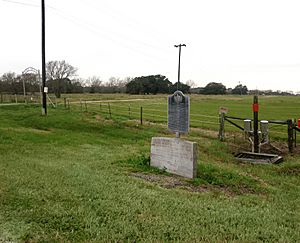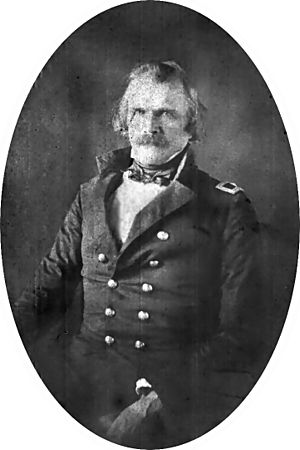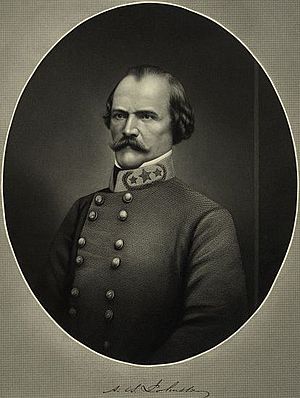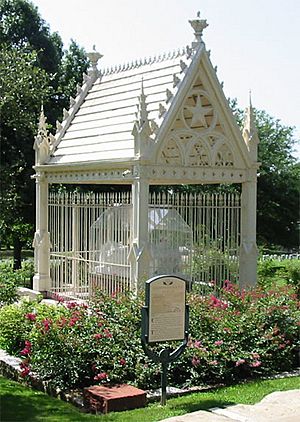Albert Sidney Johnston facts for kids
Quick facts for kids
Albert Sidney Johnston
|
|
|---|---|
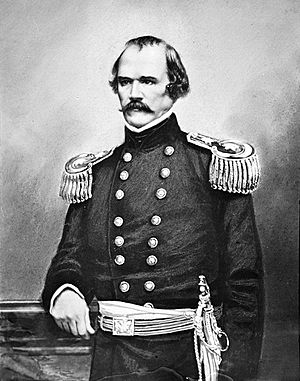
Albert Sidney Johnston, c. 1861
|
|
| Born | February 2, 1803 Washington, Kentucky, US |
| Died | April 6, 1862 (aged 59) Shiloh, Tennessee |
| Buried |
Texas State Cemetery
|
| Allegiance | |
| Service/ |
|
| Years of service | 1826–1834; 1846–1861 (USA) 1836–1840 (Republic of Texas) 1861–1862 (CSA) |
| Rank | |
| Unit | 2nd U.S. Infantry 6th U.S. Infantry Los Angeles Mounted Rifles (CSA) |
| Commands held | 1st Texas Rifles (USV) 2nd U.S. Cavalry Department of the Pacific (USA) Army of Central Kentucky (CSA) Army of Mississippi (CSA) Department No. 2 (CSA) |
| Battles/wars | Black Hawk War (1832) Texas Revolution (1835–1836) Mexican–American War (1846–1848) Utah War (1857–1858)
|
| Awards | Hall of Honor |
| Signature | |
Albert Sidney Johnston (born February 2, 1803 – died April 6, 1862) was a very important general. He served in three different armies during his career. These were the Texian Army, the United States Army, and the Confederate States Army.
Johnston fought in many wars over 34 years. He took part in the Black Hawk War, the Texas War of Independence, and the Mexican–American War. He also fought in the Utah War and the American Civil War.
Jefferson Davis, the President of the Confederate States, thought Johnston was the best general. This was before Robert E. Lee became famous. Johnston was killed early in the Civil War at the Battle of Shiloh in 1862. He was the highest-ranking Confederate officer to die in the war. Davis believed losing General Johnston changed the course of the war. Albert Sidney Johnston was not related to another Confederate general, Joseph E. Johnston.
Contents
Early Life and Education
Albert Sidney Johnston was born in Washington, Kentucky. He was the youngest son of Dr. John and Abigail Johnston. His father was from Salisbury, Connecticut. Even though he was born in Kentucky, Johnston spent most of his life in Texas. He considered Texas his true home.
He first studied at Transylvania University in Lexington, Kentucky. There, he met Jefferson Davis, who would later become a president. Both men were accepted into the United States Military Academy at West Point, New York. Johnston graduated in 1826, ranking eighth in his class. He became a second lieutenant in the 2nd U.S. Infantry.
Johnston was sent to military posts in New York and Missouri. In 1832, he served in the short Black Hawk War. He was the chief of staff for General Henry Atkinson.
Family Life
In 1829, Johnston married Henrietta Preston. She was the sister of William Preston, who later became a Civil War general. They had one son, William Preston Johnston, who also became a colonel in the Confederate Army. Johnston left the army in 1834 to care for his wife. She died two years later from tuberculosis.
After working for the Republic of Texas, Johnston returned to Kentucky. In 1843, he married Eliza Griffin, his late wife's cousin. They moved to Texas and lived on a large plantation called "China Grove." They raised Johnston's son from his first marriage and their own three children there. A sixth child was born later when they lived in Los Angeles.
Serving in the Texian Army
In 1836, Johnston moved to Texas. He joined the Texian Army as a private. This was during the Texas War of Independence against Mexico. On August 5, 1836, he became the Adjutant General of the Republic of Texas Army. On January 31, 1837, he became the senior brigadier general in charge of the Texas Army.
On February 5, 1837, Johnston fought a duel with General Felix Huston. Huston was angry about Johnston's promotion. Johnston was shot in the hip and badly hurt. He had to leave his post to recover.
On December 22, 1838, Mirabeau B. Lamar, the second president of the Republic of Texas, made Johnston the Secretary of War. Johnston helped defend the Texas border from Mexico. In 1839, he led campaigns against Native Americans in northern Texas. He resigned in February 1840 and went back to Kentucky.
Serving in the United States Army
Johnston returned to Texas during the Mexican–American War (1846–1848). He served under General Zachary Taylor as a colonel. His volunteers' enlistments ended before the Battle of Monterrey. But Johnston convinced some to stay and fight. He served as an inspector and fought at Monterrey and Buena Vista.
After the war, Johnston stayed on his plantation. In 1849, President Zachary Taylor appointed him a major in the U.S. Army. He became a paymaster, traveling thousands of miles each year. He served at Fort Mason and other places in the western U.S.
In 1855, President Franklin Pierce made him a colonel. He led the new 2nd U.S. Cavalry. His second-in-command was Robert E. Lee. Many other officers in this unit later became Civil War generals.
The Utah War
Johnston played a key role in the Utah War. In November 1857, he took command of the U.S. forces. This army was sent to make Alfred Cummings the governor of Utah Territory. He replaced Brigham Young. The army spent the winter at Fort Bridger, Wyoming. A peaceful solution was found. In June 1858, Johnston led the army through Salt Lake City. They went to set up Camp Floyd about 50 miles away. Johnston was promoted to brigadier general in 1857 for his service in Utah.
Views on Slavery
Albert Sidney Johnston owned enslaved people. He also believed that slavery should continue. In 1846, he owned a family of four enslaved people in Texas. He thought that people who wanted to end slavery were extreme. He worried they would cause problems in the Southern states.
The American Civil War
When the American Civil War began, Johnston was in charge of the U.S. Army in California. Like many officers from the Southern United States, he did not support states leaving the Union. However, he resigned from the U.S. Army when the Confederate states declared their secession. His resignation was accepted on May 6, 1861.
Johnston then moved to Los Angeles. He considered staying there with his family. But soon, he joined the Los Angeles Mounted Rifles as a private. He traveled across the southwestern deserts to Texas. On July 4, 1861, he crossed into the Confederate Territory of Arizona.
Early in the Civil War, Confederate President Jefferson Davis wanted to hold as much land as possible. He spread military forces around the borders. In the summer of 1861, Davis appointed generals to defend the Confederacy.
The areas along the Mississippi, Tennessee, and Cumberland rivers were very important. They were first commanded by Generals Leonidas Polk and Gideon J. Pillow. Their actions in Columbus, Kentucky, on September 3, 1861, caused Kentucky to lose its neutrality. Most Kentuckians then sided with the U.S. This allowed U.S. General Ulysses S. Grant to take control of Paducah, Kentucky.
Confederate Command in the West
On September 10, 1861, Johnston was given command of a huge area. This was the Confederacy's western armies, west of the Allegheny Mountains. He became a full general on August 31, 1861. This made him the second-highest-ranking general in the Confederate Army. Only Samuel Cooper ranked higher.
Johnston had less than 40,000 men spread across many states. He also lacked enough weapons and supplies. The Confederate government focused on forces in the East. They sent Johnston few reinforcements. Johnston used raids and other tricks to make his forces seem larger. This worked for several months. His tactics confused U.S. General William Tecumseh Sherman in Kentucky. Sherman was later replaced.
Battle of Mill Springs
East Tennessee was mostly pro-U.S. during the war. It was held by Confederate generals Felix Zollicoffer and George B. Crittenden. Zollicoffer, though brave, was not experienced. He moved his forces into a bad position near Mill Springs. He put a river behind his troops, trapping them.
On January 19, 1862, at the Battle of Mill Springs, the Confederates attacked. They were not ready and had marched all night in the rain. Zollicoffer was killed. Crittenden could not lead effectively. The Confederates were defeated by a U.S. bayonet charge. They lost 533 men out of 4,000.
After this defeat, Davis sent Johnston some reinforcements. He also sent General P. G. T. Beauregard. Beauregard was known for his early victories.
Fort Henry, Fort Donelson, and Nashville
Two forts were built to defend the Tennessee and Cumberland rivers. These rivers led into Tennessee from the north. Fort Henry on the Tennessee River was in a low area. Hills on the Kentucky side overlooked it. Fort Donelson on the Cumberland River was better located. But its land side was weak, and it lacked heavy guns.
Johnston ordered the forts to be strengthened. He wanted Major Alexander P. Stewart to command them. But President Davis appointed General Lloyd Tilghman. Johnston also sent General Gideon Pillow and 5,000 men to Fort Donelson.
On February 6, 1862, U.S. gunboats quickly took Fort Henry. General Tilghman surrendered the remaining 94 men. Johnston knew he could be trapped if Fort Donelson fell. So, he moved his forces to Nashville, the capital of Tennessee.
Johnston sent 12,000 more men to Fort Donelson. He told the commanders to leave if they could not hold the fort. Generals Pillow and John B. Floyd were in charge. They wasted their chance to escape. On February 16, 1862, General Simon Buckner surrendered Fort Donelson. Floyd and Pillow had abandoned him. Colonel Nathan Bedford Forrest escaped with his cavalry. The Confederates lost about 1,500 men and 12,000 to 14,000 were captured.
Johnston took the blame for the loss. People called for his removal. He had spread his forces too thin. He also relied on generals who were not good leaders. The fall of the forts left Nashville open to attack. Nashville fell to U.S. forces on February 25, 1862. Johnston had to pull his forces out to avoid capture.
Gathering Forces at Corinth
Johnston had many scattered military units. They were retreating south to avoid being cut off. Johnston himself retreated with his force, the Army of Central Kentucky. With Beauregard's help, Johnston decided to gather forces at Corinth, Mississippi. This was a key railroad crossroads. Johnston kept the U.S. forces confused and slow. This allowed him to reach Corinth without being noticed.
This delay also allowed Jefferson Davis to send reinforcements. General Braxton Bragg arrived to help organize the western forces. Bragg helped calm Beauregard and Polk. They had been worried about their situation. Johnston arrived on March 24, 1862.
Johnston's army had 17,000 men. This gave the Confederates a total of about 40,000 to 44,669 men at Corinth. On March 29, 1862, Johnston took command of this combined force. It was called the Army of the Mississippi.
Johnston planned to defeat the U.S. forces one by one. Grant had 40,000 men nearby. General Don Carlos Buell was coming from Nashville with 35,000 men. Johnston wanted to surprise Grant's force before they could join up. He started his army moving on April 3, 1862. But they moved slowly because they were new and the roads were bad.
Because of the delays, Beauregard thought the surprise was lost. He suggested calling off the attack. But Johnston decided to go ahead. He said, "I would fight them if they were a million." His army was finally in position by the evening of April 5, 1862. They were just a mile or two from Grant's force, still undetected.
Battle of Shiloh and Death
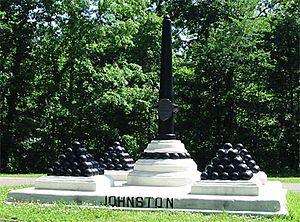
Johnston launched a huge surprise attack against Grant at the Battle of Shiloh on April 6, 1862. The Confederate forces quickly overran the U.S. camps. Johnston rode his horse up and down the line, encouraging his troops.
At one point, he saw some soldiers taking things from the U.S. camps. He was angry to see a young officer among them. "None of that, sir," Johnston yelled. "We are not here for plunder." Then, to make the officer feel better, he picked up a tin cup. "Let this be my share of the spoils today," he said, and led his army forward.
Around 2:30 p.m., Johnston was leading a charge. He was wounded by a bullet behind his right knee. The bullet hit an artery, and his boot filled with blood. No doctors were nearby. Johnston had sent his own surgeon to help other wounded soldiers.
Within minutes, Johnston began to faint. Isham G. Harris, the Governor of Tennessee, was with him. Harris saw Johnston slumping and looking pale. "General, are you wounded?" Harris asked. Johnston looked at his leg and said his last words weakly: "Yes... and I fear seriously."
Harris and other officers took Johnston off his horse. They carried him to a small ditch. They tried to help him, but he lost consciousness. Harris sent for Johnston's surgeon but did not put a tourniquet on the wound. A few minutes later, Johnston died from blood loss. He had a tourniquet in his pocket, but it was not used.
Harris and the officers wrapped Johnston's body in a blanket. They did not want the troops to see their dead general. Johnston's body was taken to his field headquarters. General P. G. T. Beauregard took command of the army. He continued the Confederate attack. They pushed the U.S. forces back to a final line near the Tennessee River.
Beauregard stopped the attack around 7 p.m. His army was tired, and it was getting dark. He thought they could finish off the U.S. army the next morning. However, Grant received 20,000 fresh troops overnight. These were from Don Carlos Buell's army. The next day, Grant led a successful counter-attack. He drove the Confederates away and won the battle. Johnston's body was taken to his headquarters in Corinth. It was covered in the Confederate flag.
It is thought that a Confederate soldier might have accidentally fired the shot that killed Johnston. Many Confederates were firing at the U.S. lines. Johnston was charging far ahead of his own soldiers.
Johnston was the highest-ranking officer to die in the war for either side. His death was a big blow to the Confederacy. At the time, President Davis thought he was the best general in the country.
Legacy and Honors
Johnston was survived by his wife, Eliza, and six children. His wife and five younger children lived in Los Angeles. Johnston's oldest son, Albert Sidney Jr., also joined the Confederate Army. In 1863, Albert Jr. was killed in an accident. He was on a ferry in San Pedro harbor when a steamer's boilers exploded.
After his death, General Johnston received high praise from the Confederate government. News about his family was published in the Los Angeles Star. Streets in northeast Los Angeles are named after Johnston and his family.
Johnston was first buried in New Orleans. In 1866, the Texas Legislature voted to move his body. He was reburied at the Texas State Cemetery in Austin in 1867. Forty years later, Elisabet Ney designed a monument and sculpture for his grave site. It was put up in 1905.
The Texas Historical Commission placed a historical marker near Johnston's former plantation. Other groups also put up a marker there.
In 1916, the University of Texas at Austin honored several Confederate veterans with statues. Johnston's statue was one of them. On August 21, 2017, his statue was taken down. This was part of a movement to remove Confederate monuments. Plans were made to move it to the Dolph Briscoe Center for American History.
Johnston was added to the Texas Military Hall of Honor in 1980.
In 2018, A. S. Johnston Elementary School in Dallas, Texas, was renamed Cedar Crest Elementary. Johnston Middle School in Houston, Texas, was renamed Meyerland Middle School. Three other schools named after Confederate veterans were also renamed at the same time.
See Also
 In Spanish: Albert Sidney Johnston para niños
In Spanish: Albert Sidney Johnston para niños


